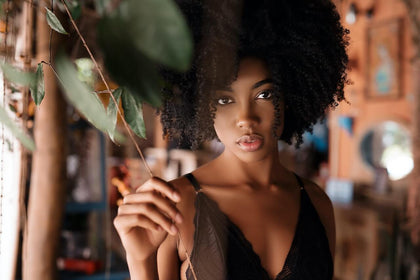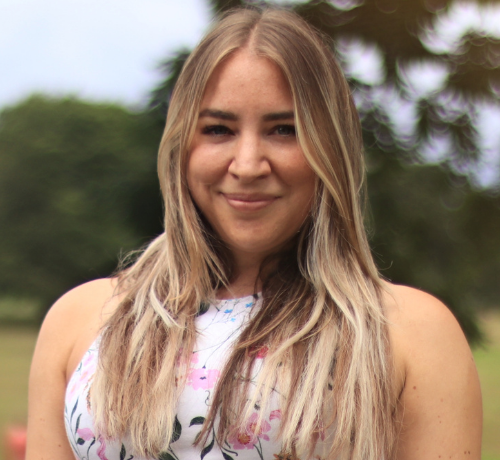You might wonder why some people have curls and some don't. What makes hair curly, and what's the science behind it?
Get to know curly, kinky and coily hair better with this guide — plus, discover the products you need to keep your strands gorgeous, glossy, strong and long.
How Curly Hair is Formed
Hair is important to the human body because it helps protect the scalp from harmful UV rays and keeps it warm in cooler weather. Hair follicles found under the skin's surface are complex and multicellular and are where the hair shape is formed.
Curly hair has many different hair fiber shapes, including twists, curls, crimps, frizz and kinks. Research shows that the shape and structure of hair follicles are determined during embryonic development, but science still debates how this process happens. Curly hair follicles have an S-shape curvature, meaning the hair bends twice. Straight hair follicles fall vertically from the scalp and the skin's surface to form straight hair fibers. Once determined, your hair might change over time, but the hair and follicle shape is generally set for life.
Shop Products Loved by Millions: VEGAMOUR's Best Sellers
#include-related-slider#
In Your Genes
Much like your height and your skin color, hair is something determined by your genetics. If one parent has curly or wavy hair, you might also experience curls because our genes influence our hair shape. A 2009 study found that genes for curly hair are 85%-95% heritable, which means that the texture of someone's hair can often be linked back to their DNA. The study also found that Trichohyalin (TCHH) is the gene that produces a protein that helps strengthen hair. Symmetry also plays a part in your hair structure: If the hair follicles are asymmetrical, oval-shaped hair is produced, which tends to curl as it grows. Straight hair fibers have a symmetrical shape.
Read: How to Hydrate Curly Hair
The Structure of Curly Hair
What makes your hair curl? It has a lot to do with the shape of your hair follicle. Gaby Longsworth, Ph.D., certified hair practitioner and owner of Absolutely Everything Curly, told VEGAMOUR, "The shape of the follicle determines whether sprouting hair will be straight, wavy, curly or coily. The hair bulb is located at the base of the hair follicle, and its shape also plays somewhat of a role. The bulb is slightly hooked in people with curly hair, whereas people with straight hair have little to no hook on the bulb.
The hair shaft is what you see when the hair grows out and away from your follicle. The composition of a strand influences your hair texture. Research that took place in 2007 investigated several different hair samples to observe structural differences. Comparing curly and straight hairs using electron microscopy, scientists found that curly hairs experienced an uneven distribution of the protein keratin. The hair shaft itself is made up of dead cells. Keratin is a tough primary component of hair that keeps it looking healthy and shiny.
Your hair shaft has three distinct layers:
The Cuticle
The cuticle is the hair's protective layer that's comprised of overlapping protein layers. Curly hair and hair that's been chemically processed or colored have a raised cuticle. Curly hair is more susceptible to cuticle damage because it has a lower internal moisture level. As the cuticle bends, it can break, causing hair to become more tangled.
Read: Should You Sleep With Wet Curly Hair?
The Cortex
The cortex forms the pigment and bulk of your hair. It's comprised of keratin filaments held together by hydrogen bonds and disulfide. Disulfide bonds are considered incredibly strong. Although the shape and placement of the hair follicle determine how curly your hair is, the disulfide bonds are what keep the hair holding on to its shape. The healthier your cuticle, the more protected your cortex is.
The Medulla
The medulla is often only present for those with thicker hair types. It is the innermost layer within the hair shaft, consisting of a dense core of transparent cells and air spaces.
Related: What to Know About Hair Structure and Composition
Different Types of Curls
Straight hair is easy to categorize, but curly hair is more complicated. So, to help, Longsworth defined the types for us:
Type 2: Hair With Waves
- 2A: Curls are tousled, loose and lack definition.
- 2B: Hair is straight at the roots but begins to have S-shaped waves toward the mid-lengths and ends.
- 2C: Well-defined waves that start at the root with ringlets and curls.
Type 3: Hair With Curls
- 3A: Curls are the size of a wine-bottle cork or larger and have a clear, loopy S-shape.
- 3B: Curls are coarse, springy and tighter than the width of a sharpie pen or index finger.
- 3C: Curls are tight, dense and the size of a straw or a pencil.
Type 4: Coily Hair
- 4A: Curls are tight, small and coily. Curls can wrap around a crochet needle.
- 4B: Curls don't form a typical S pattern but are bent, sharp, zigzagged and Z-shaped.
- 4C: Curls are tightly coiled like a spring in a pen and less defined.
Also: How and Why to Plop Your Curly Hair
Caring for Your Curls
Longsworth told VEGAMOUR, "There is no such thing as an ideal hair care routine for curly hair because an effective routine depends on many different hair characteristics such as strand thickness, hair density, elasticity, the health of the hair, whether the hair is gray, colored or natural and [its] porosity." Once you've determined your hair curl type, you can consult with a stylist to ensure you tend to it most appropriately.
In general, if nature has blessed you with curly locks, make sure you avoid brushing your hair when it's wet. When the hair is swollen with water particles, it's more likely to get damaged — especially if you're using a harsh bristle brush. If your curly hair has undergone a relaxing treatment (to make the strands straighter), make sure you keep your hair as healthy as possible by washing it with hydrating and nourishing formulas.
For example, GRO Revitalizing Conditioner & Shampoo won't drag curly strands down or make them too fluffy. The powerful plant formula is enhanced with VEGAMOUR's proprietary Karmatin™ (the first-of-its-kind vegan keratin), which bonds protectively to follicles and strands, giving hair a gorgeous, glossy shine. Plus, the duo contains wild-harvested marula oil, organic murumuru butter and ximenia oil to help hydrate and condition your hair.
The Final Word
Just like other parts of the human body, how your hair is structured is intricate and complex. Take a holistic approach to the health of your body and your hair by following a healthy diet, getting plenty of quality sleep and reducing stress as much as possible. Additionally, help your curly strands thrive by avoiding hot tools, and making a habit of using hair products that don't contain any sulfates, silicones or harsh chemicals. Follow these steps, and you'll see your hair thrive!
#include-related-slider#
More From VEGAMOUR
- 9 Hair Wellness Habits to Add to Your Routine
- This Is My Favorite Shampoo Formulated Without Sulfates
- How to Use Hair Oil for Shiny, Gorgeous Hair
Photo credit: Lucas da Miranda/Pexels
Back



















